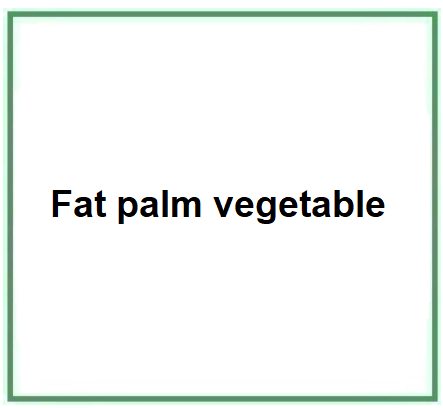Fat palm vegetable is obtained, in the same way as palm oil, from the pulp of the palm with a process of breaking the plant and squeezing the marrow.
There are two oil extraction systems:
- The Dry extraction uses mechanical presses that crush the plant
- The Damp extraction uses hot water to filter the oil
The resulting product is impure, as there are many plant residues, cellular debris and fibrous material. At this point the hot water is inserted to form a barrier in which the solids fall towards the bottom of the container, releasing the oil that will pass into sieves.
Due to its low cost, this fat is a widespread nutritional source in developing countries.
Raw materials used in production.
Palm fat is derived from the pulp of the fruit of the palm, specifically from the species Elaeis guineensis. The oil palm plant is primarily cultivated in equatorial regions like Indonesia and Malaysia.
Step-by-step summary of industrial production process.
- Harvesting. Palm fruits are harvested either manually or mechanically.
- Extraction. The fruits are pressed to extract the oil from the pulp.
- Refining. The extracted oil is refined to remove impurities and stabilize it.
- Fractionation. The oil can be fractionated into different fat fractions with varying physical characteristics.
Form and color.
Palm fat is semi-solid at room temperature and varies in color from yellow to red, depending on the degree of refinement and the presence of carotenoids.
Commercial applications.
Widely used in the food industry, cosmetics, and in the production of biodiesel due to its thermal stability and preservative properties.
Food Industry. Palm fat is used as a structuring and stabilizing agent in various food products like biscuits, chocolate, and snacks, owing to its excellent melting and solidifying properties.
Cosmetic Industry. Palm fat can be utilized in creams, lotions, and other skin-care products for its emollient and moistening properties.
Biofuel Production. In some instances, palm fat may be used in the production of biofuels, providing a sustainable energy alternative.
Soap Industry. Palm fat is often utilized in soap production for its ability to provide good structure and lather.
Inside the palm fat we find a high content of saturated fat and palmitic acid.
However, from recent studies, a connection seems established between this fat and some cardiovascular disorders. (1) especially when heated (2)
Another problem related to palm fat is the increasing deforestation put in place to plant huge amounts of palm trees.
Palm fat is used in animal feed.
There is also a "red" palm oil on the market with slightly better physical and taste characteristics.
Palm fat studies
References___________________________________________________________________
(1) Chen BK, Seligman B, Farquhar JW, Goldhaber-Fiebert JD. Multi-Country analysis of palm oil consumption and cardiovascular disease mortality for countries at different stages of economic development: 1980-1997. Global Health. 2011 Dec 16;7(1):45. doi: 10.1186/1744-8603-7-45.
(2) Xian TK, Omar NA, Ying LW, Hamzah A, Raj S, Jaarin K, Othman F, Hussan F. Reheated palm oil consumption and risk of atherosclerosis: evidence at ultrastructural level. Evid Based Complement Alternat Med. 2012;2012:828170. doi: 10.1155/2012/828170. Epub 2012 Dec 19.
![]() Fat palm vegetable
Fat palm vegetable 

